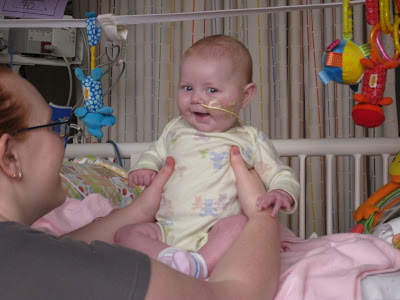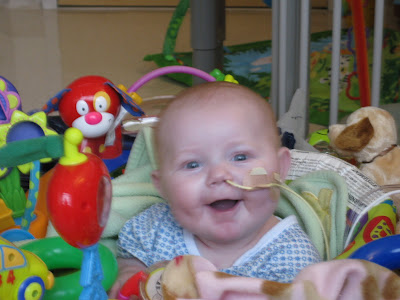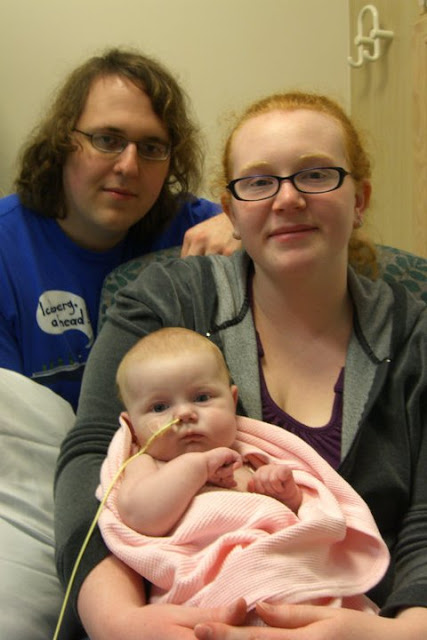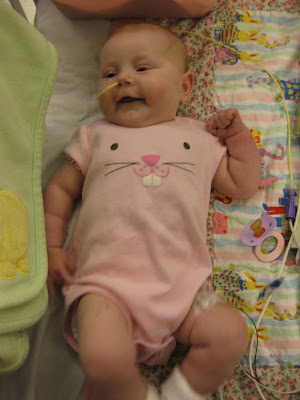If you've read the surgeon's perspective post or the main cath post previously, you know already that what was discovered during the cath was a big enough deal to send Lillian back to the CICU (Cardiac Intensive Care Unit) after the procedure for the long term. It is normal for kids to be sent to the CICU after a cath, but most are only there for a short while, rather than for long term management, which is why Lillian was sent back.
 |
| Normal heart with 2 coronary arteries |
With the discovery of the single coronary physiology (to recap, she only has one coronary artery on the right side of her heart, normal is one on each side of the heart, see picture above), we knew Lillian would need special care even with the coarctation (blockage) cleared. We did know from the Norwood procedure that the right coronary artery she does have mutated and expanded to go up the left side, but we weren't sure at the time how the blood flowed through her heart. The cath confirmed that there is no blood flow through the left coronary artery (perhaps its a misnomer to say she has a single coronary physiology as it is my understanding that she does in fact have a left coronary artery; but it is so small (~1mm) that there is no blood flow through it, and it is too small for us to balloon it). Even though Lillian doesn't have the pumping chamber on the left side of her heart, it still needs to be fed blood otherwise it might cause the side that she does have to die out. This then was our goal in the CICU; to see if we could either restore blood flow through the left coronary artery (it possibly had blood flow at a time before the cath, but we don't know if it did or not) or if we could get enough blood flow through the right coronary artery to sustain her heart.
To help keep Lillian's heart stable and strong after the surgery, and to hopefully accomplish either getting enough blood flow to the left side of the heart, we began Milrinone therapy when she returned to the CICU. Those of you who have been reading since the beginning might remember Milrinone as one of the medicines she was being given after the Norwood, and it serves the same purpose here; mainly dilating the coronary arteries feeding the heart making it easier to get blood to her heart, thus relaxing it and making it pump better. Milrinone also seems to have some sort of healing properties restoring some amount of function to the heart even after the medicine is stopped, although I don't entirely understand why this effect lasts in some (but not all) cases. That was what we were going for, as Lillian would need to recover heart function to continue along the surgical track, which is what we would prefer her to be on.
The first day post cath/start of Milrinone therapy made us optimistic, Lillian's hands and feet were warm to the touch, something that we had never experienced before (as a blood mixer who doesn't have the standard 95 to 100% saturations, Lillian's extremities are typically cold). Her BNP had also gone down to 1220, a promising improvement from the 1740 reading that caused us to do the cath emergently in the first place. (as a refresher, BNP is a hormone that indicates heart distress, a normal person without heart disease should be under 100, and over 500 is generally considered catastrophic, so Lillian was high to say the least). She also was acting like she was feeling better, getting back to her happier self.
Even though Lillian was showing promising signs on the Milrinone therapy, Children's staff still wanted to have Lillian evaluated by the heart failure/transplant doctors as the single coronary physiology is not normally sustainable. The heart failure doctor (we spoke with Dr. Yuk Law, who is the director of the Heart Transplant program but one of 3 rotating doctors; the other two are Dr. Mariska Kemna and Dr. Robert Boucek; they each are attending for a week at a time, rotating between the three of them) was hopeful but not optimistic. He told us it was unlikely that Lillian would be able to remain stable with her single coronary physiology, but that we would have to wait and see how she responded to the Milrinone therapy.
Lillian's response to Milrinone therapy was eventful to say the least. The second day after the cath Lillian's BNP shot up to 2570, the highest it had ever been and far higher than we would have expected it to be after the cath. However, even with the numbers showing alarming information, Lillian was acting fine, so we continued with the therapy. The day wasn't free from drama though. Lillian had an arterial line placed with the cath to deliver medicine, but we needed to remove it due to being unable to stop the site from oozing blood. This removal caused her blood pressure to disappear in her legs for 15 minutes, turning them blue while the nurses worked to get blood flow back. In the end, no harm was done, but it's always a little disconcerting losing pulses in any part of the body on a heart patient.
 |
| Sleeping peacefully |
By Wednesday the 27th, 4 days after the cath, we still had not seen any sign of recovery in terms of heart function. Her heart was still pumping roughly the same amount of blood as before, and there were still issues with the right ventricle pumping properly. I forget if I've mentioned this before (and forgive me if I'm restating what is already in this post, this one was written over a month due to other obligations), but the right ventricle that she does have has issues with properly squeezing the bottom half of the chamber, pumping less blood than she needs and presenting the risk of a clot forming inside the heart (as another aside, if you go back to the cath posts, you can see this dysfunction in the chamber she does have) We needed to ensure proper blood flow to the heart so this chamber didn't get any weaker, as it is the only one she has. Without seeing any improvement at this point the Dr. Law already thought that she wouldn't recover enough and would have to go down the transplant path, but we weren't rushing to that decision considering it's gravity.
I'm going to jump on a little tangent here and explain the process for deciding treatment for HLHS and other congenital heart disease kids in general. Most kids with minor CHD problems are better served with appropriate surgery as their problems and and surgical side effects are relatively manageable. We also try to do surgery whenever possible for kids with more serious conditions like HLHS or coronary fistula (where the coronary arteries are inside the heart rather than outside of it); but surgery sometimes isn't enough because of the severity of the condition. For the children who have surgery but still won't survive with it, we have one final option: a heart transplant. There are advantages and disadvantages to both the surgical track and the transplant track, so many that I can't hope to list more than the most significant here. In terms of the surgical track, the advantages are that you have your own heart, and even if it is surgically repaired, your own heart is generally better than a transplanted one due to the anti-rejection medicines all transplant patients must take for the rest of their life. There is no risk of rejection with your own heart, but the risk of the repair failing at some point is always there. However, the surgical track is not fool proof. The 5 year survival rate on the first 3 surgeries of HLHS is around 70%, so they're not without risk. The first surgery, the Norwood, has a 10% fatality rate alone due to the stress of the operation. The transplant track has the disadvantage of taking anti-rejection medicines; medicines so strong that you need other medicine to counteract their side effects, and then other medicine to counteract the first other medicine's side effects (whew!). Anti rejection medicines are also immune suppressants, so taking them is tantamount to giving yourself AIDS. They have many other side effects, ranging from excessive hair growth to liver and kidney failure. At this point you're probably asking why would anyone do a transplant? The answer to that question is that once a CHD child has a transplanted heart, they no longer have CHD. The transplanted heart is a healthy, fully functional heart that allows for a normal life outside of the medicines, and we can partially manage their side effects or reduce them over time. This is in comparison with a Fontan circulation child (a child who has finished the surgical track for HLHS), who despite having their own heart, still has half a heart. They have much less energy than normal, hit brick walls in physical activity, tend to be extremely petite, and the girls can never have children due to the stress it would cause. None of these issues apply to transplant patients, they have normal hearts. Of course now you're asking why don't we do transplants for every CHD patient who needs it? And the simple answer is that we would, but we don't have enough hearts. There's not exactly an abundant supply of infant hearts (and please don't get me wrong, this is a good thing); and the small number of infants who do unfortunately pass so early either don't have their organs donated by their families for various reasons or aren't suitable donors. The lack of donors is the sole reason that the surgical track was created in the first place, with the transplant track now being reserved for the most serious of patients for whom even the surgical track will not work.
Now that you understand the reasoning for not giving every CHD patient a transplant, you should understand a little better why we wanted to see if Lillian could recover function and stay on the surgical track. Even though we hadn't seen any sign of heart function recovery yet, we still wanted to give Lillian the best shot possible for it. With that in mind, we planned an X-ray and echocardiogram for October 31st, later pushed back to November 1st, which would determine which track we would be on. If she recovered function, we would stay on the surgical track, and if she stayed the same, we would have to go transplant.
 |
| Lillian on the day of the ECHO |
The ECHO results showed us exactly what we had seen earlier: no improvement at all. However, despite our understanding that this would put us on the transplant list, the heart failure team wasn't ready to commit to that option first. Even though she hadn't recovered any function, they told us what really mattered was if the function that she did have would be enough to sustain her. For some kids, a little loss in heart function isn't enough to sustain them. In contrast, other kids can lose a ton of function and still act and behave normally, eating properly and everything. In the end, this is what matters. In that regard, we decided to do a Milrinone wean, seeing how well Lillian's heart would function without it. If she couldn't function without it, we would list her and if she could, she would remain on the surgical track. Kathryn and I wanted to start the listing process at this point, as our gut feeling was that the wean would fail, but to be listed you have to demonstrate actual need. Failing a Milrinone wean is one such way to demonstrate this need, so we needed to see if she would fail or not before she was listed.
Milrinone weans are typically done as a half cut a day. That means that if you are at 0.5 mcg/kg/min as Lillian was, you would go down to 0.25 on the first day, 0.125 on the second, and then either to 0.0625 or 0, depending on the patient. We knew Lillian was fragile, so we planned on doing the wean at 0.1 mcg/kg/min a day, so that she would be off of it entirely after 5 days. Lillian reacted extremely poorly to this wean, with higher oxygen saturations on the first day, and drastic blood pressure drops and vomiting on the second, failing the wean at 0.3 mcg/kg/min. However,she had shown some positive signs during the wean, including a drastically lower BNP, as low as 200.
With Lillian failing the wean, Kathryn and I started to push heavily to start the transplant listing process. However, Children's staff wanted to do one more trial wean, but slower this time and with other possible causes removed. I'm still not sure why we weren't able to start the transplant evaluation at this point, but as the surgical track is my preferred option, I was OK with trying one more wean. This wean would still be at .1 mcg/kg/min at a time, but this time turned down every two days as opposed to every one, effectively making this wean 5 times slower as a typical one. We also switched her NG feeding tube (ends in her stomach) to a ND feeding tube (ends in her upper intestines) hoping to rule out acid reflux as a possible cause of the vomiting that caused us to abandon the wean last time.
While waiting at the second day of the wean (still at .4 mcg/kg/min) we were able to begin the transplant listing process by drawing and completing a blood work evaluation, the single most important pre transplant evaluation. Most of the rest of the evaluations would have to wait on the results of the wean, but it was encouraging that we were at least tentatively starting them so that we could list her quickly if the wean did fail. However, the wean was looking like it was going well, so we finally had some good news. Lillian sailed through the 0.3 mcg/kg/min rate that she had failed at the first time, and she got all the way through the wean so that we could turn it off. We were hopeful that she would actually be able to stay stable with the Milrinone off, but with her BNP skyrocketing up to 700 we knew that she might have to be put back on Milrinone at any moment. But just seeing the Milrinone off was encouraging, and the fact that the ECHO looked unchanged (which is good since it wasn't worse) gave us a little more hope for getting out of the woods.
Lillian did well the first day of having the Milrinone off, but spit up a total of 10 times on the next day, a traditional sign of heart failure for her. However, her BNP was down to 319, so she was giving us very mixed signals. These signals were enough for us to continue a little further in the evaluations, doing both the cardiac anesthesia and nutrition evaluations on Lillian and a blood antibody check on Kathryn to see what she might have passed on to Lillian during birth.
 |
| Annabelle getting in on the doctor action |
At this point, even with Lillian fully off the Milrinone and stable for the moment, we decided to go full steam ahead with the transplant evaluation. Lillian had been declining slowly since we had turned it off; but we also knew that she had recovered absolutely zero heart function over the Milrinone therapy, and we knew her heart wouldn't be strong enough to sustain the circulation that the second surgery would give her. Her heart was barely able to sustain her circulation as it was. She was also spitting up like crazy and getting worse every day. We would still wait and see how she did long term off Milrinone, but in the mean time we also did her HIV evaluation (mandatory for all transplants as she had a small chance of getting it from a blood transfusion earlier), social work eval, infectious diseases eval and a neurology eval, all with the goal of being able to list her quickly if and when that decision was made.
Lillian remained fairly stable for a while after the Milrinone was turned off, but she started getting worse not long after that, spitting up more and giving us other signs. Despite the way things looked, Children's still decided to send us to floor even with Lillian's declining condition, with the expectation that if the decline continued, we would be right back in the CICU. This proved to be correct, as we were back in the CICU after 3 days; brought around by a dramatic show of 6 emesis (spit up/vomiting) in 45 min and a drop in her heart rate into the 80s (normally in the 120s to 160s).
 |
| Derping it up on the floor before going back to CICU |
At this point, the need for a transplant was clear and we knew that was the path we would be taking. But before Children's does any non emergent surgery or treatment, the patient's case and back story are presented at a multidisciplinary conference to get as much input and make the best choice possible. Lillian was presented at the conference for transplant on November 22nd, where the consensus was transplant, as expected, depending on one more evaluation. That evaluation, a HLA antigen eval, came back as extremely weak (which is what we want), allowing us to sign the consent form, the last step to listing. Of course, it should be the last step before transplant, but we then had to deal with a 2 day hiccup caused by a lazy Cigna case worker leaving work at 1:30PM and Cigna wanting a dental evaluation on a 4 month old baby without teeth. Why any one would need a dental evaluation for a heart transplant is beyond me, but especially when you don't even have teeth.
Despite the road blocks that Cigna tried to throw up, Lillian was listed for a heart transplant on November 24th, 2010. She was listed as Status 1A (in order, they are 1A, 1B, 2 and 7, or inactive), and was number one on the list for her priority (the highest) in her blood type (A) in our region (region 6, encompassing Washington, Oregon, Idaho, Montana, Alaska and Hawaii) of her size. A mouthful for sure, but there are many qualifiers. The most important of these qualifiers is size, as an infant can generally receive a mismatched organ and adapt to it due to the relative immaturity of their immune systems. This means that even though Lillian is blood type A, she could receive a B heart (provided there were no other B patients of course) and generally do fine, while this would be fatal for an older child or an adult.
Not much has happened between the listing and today. We were in the hospital for Christmas, where Lillian and Annabelle got a personal visit from Santa and presents from the hospital staff.That's functionally the biggest event that happened, so I'm going to wrap up this uber long post with a quick picture dump of the 2 months between the listing and today.
 |
| Being cute for Christmas |
 |
| Asleep with our Project Linus blanket |
 |
| Hamming it up |
 |
| And for good measure, one of Annabelle's legendary photobombs. |
It's been an interesting few months waiting for a transplant. The hospital has functionally become our home, although we still use our actual one for sleeping, if not much else. Lillian has come a long ways even from the listing, and is getting smarter and more aware every day. The similarities between her and Annabelle are really starting to show through, although I feel that Lillian will be shy in the long run due to how much of her life she has spent at the hospital. It is now January 31st. We have been in the hospital since October 22nd (102 days, or 3 months, 10 days), and listed since November 24th (69 days, or 2 months, 8 days).













